Business Economics Report: Market Structures, Pricing, and Competition
VerifiedAdded on 2023/01/04
|17
|3257
|74
Report
AI Summary
This business economics report delves into various market structures, including oligopolies, monopolies, and perfect competition, providing definitions and discussions of each. It examines the impact of supermarket giants on privately owned local grocery stores, analyzing the effects on competition and pricing. The report includes a comparative table of food prices across different stores, highlighting total shopping cost differences. It further explores competitiveness and segmentation within the food market, offering insights into pricing strategies and market dynamics. The analysis provides a detailed overview of market structures, pricing strategies, and the competitive landscape of the food market, with a focus on the implications for both large supermarket chains and smaller local businesses. The report concludes with a comprehensive evaluation of the competitive dynamics and economic factors influencing the food industry.

Business economics
Paraphrase This Document
Need a fresh take? Get an instant paraphrase of this document with our AI Paraphraser
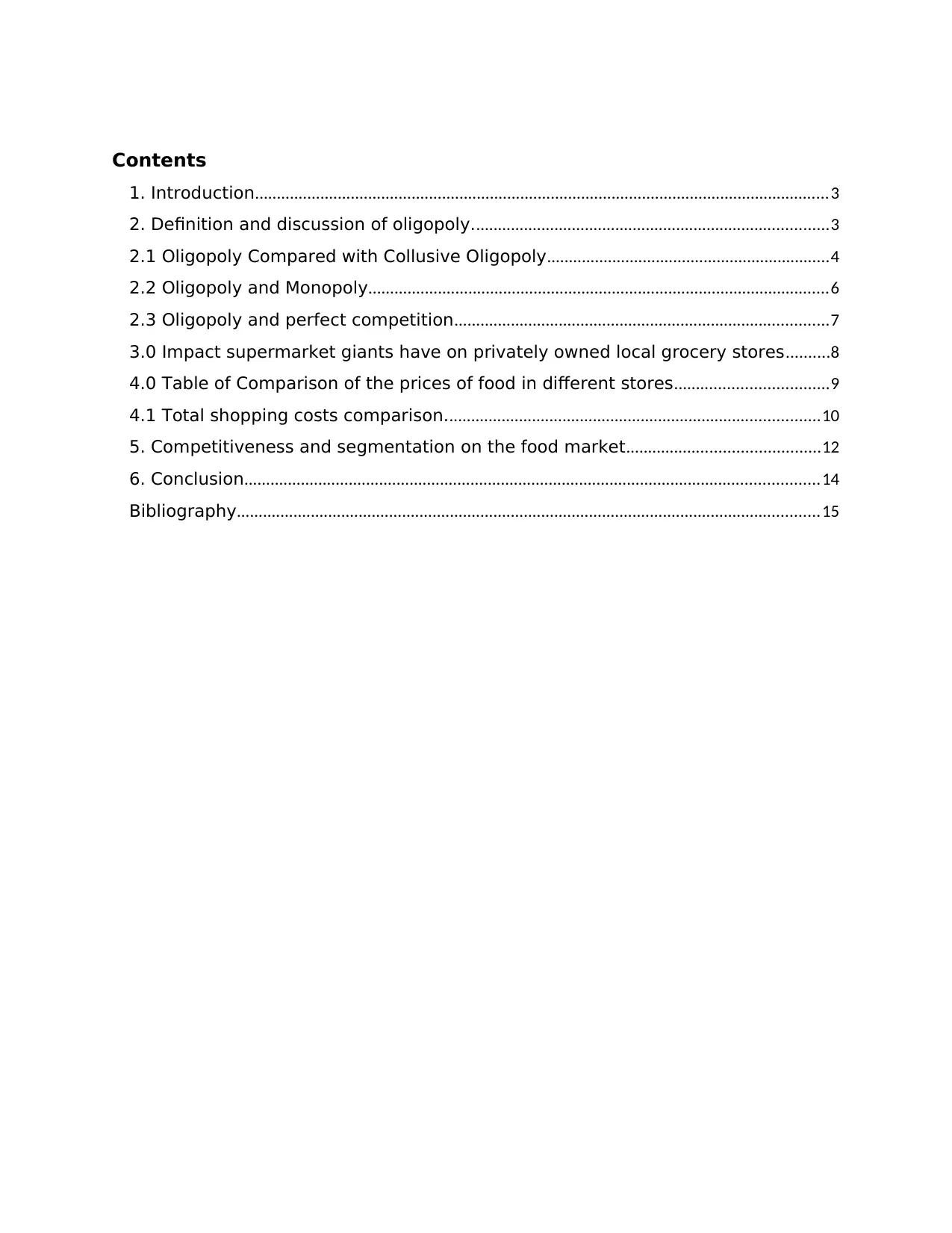
Contents
1. Introduction....................................................................................................................................3
2. Definition and discussion of oligopoly..................................................................................3
2.1 Oligopoly Compared with Collusive Oligopoly.................................................................4
2.2 Oligopoly and Monopoly..........................................................................................................6
2.3 Oligopoly and perfect competition......................................................................................7
3.0 Impact supermarket giants have on privately owned local grocery stores..........8
4.0 Table of Comparison of the prices of food in different stores...................................9
4.1 Total shopping costs comparison......................................................................................10
5. Competitiveness and segmentation on the food market............................................12
6. Conclusion....................................................................................................................................14
Bibliography......................................................................................................................................15
1. Introduction....................................................................................................................................3
2. Definition and discussion of oligopoly..................................................................................3
2.1 Oligopoly Compared with Collusive Oligopoly.................................................................4
2.2 Oligopoly and Monopoly..........................................................................................................6
2.3 Oligopoly and perfect competition......................................................................................7
3.0 Impact supermarket giants have on privately owned local grocery stores..........8
4.0 Table of Comparison of the prices of food in different stores...................................9
4.1 Total shopping costs comparison......................................................................................10
5. Competitiveness and segmentation on the food market............................................12
6. Conclusion....................................................................................................................................14
Bibliography......................................................................................................................................15
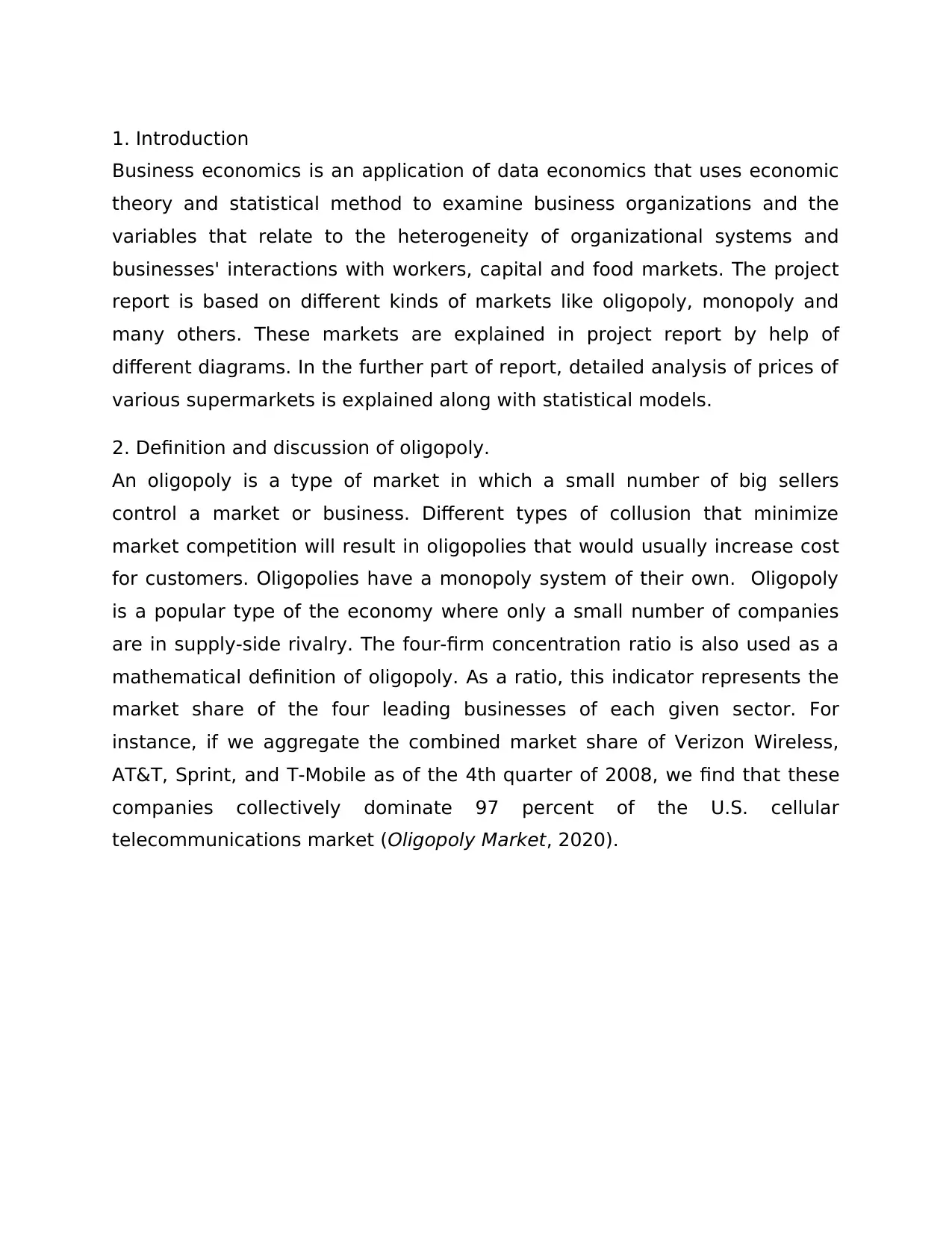
1. Introduction
Business economics is an application of data economics that uses economic
theory and statistical method to examine business organizations and the
variables that relate to the heterogeneity of organizational systems and
businesses' interactions with workers, capital and food markets. The project
report is based on different kinds of markets like oligopoly, monopoly and
many others. These markets are explained in project report by help of
different diagrams. In the further part of report, detailed analysis of prices of
various supermarkets is explained along with statistical models.
2. Definition and discussion of oligopoly.
An oligopoly is a type of market in which a small number of big sellers
control a market or business. Different types of collusion that minimize
market competition will result in oligopolies that would usually increase cost
for customers. Oligopolies have a monopoly system of their own. Oligopoly
is a popular type of the economy where only a small number of companies
are in supply-side rivalry. The four-firm concentration ratio is also used as a
mathematical definition of oligopoly. As a ratio, this indicator represents the
market share of the four leading businesses of each given sector. For
instance, if we aggregate the combined market share of Verizon Wireless,
AT&T, Sprint, and T-Mobile as of the 4th quarter of 2008, we find that these
companies collectively dominate 97 percent of the U.S. cellular
telecommunications market (Oligopoly Market, 2020).
Business economics is an application of data economics that uses economic
theory and statistical method to examine business organizations and the
variables that relate to the heterogeneity of organizational systems and
businesses' interactions with workers, capital and food markets. The project
report is based on different kinds of markets like oligopoly, monopoly and
many others. These markets are explained in project report by help of
different diagrams. In the further part of report, detailed analysis of prices of
various supermarkets is explained along with statistical models.
2. Definition and discussion of oligopoly.
An oligopoly is a type of market in which a small number of big sellers
control a market or business. Different types of collusion that minimize
market competition will result in oligopolies that would usually increase cost
for customers. Oligopolies have a monopoly system of their own. Oligopoly
is a popular type of the economy where only a small number of companies
are in supply-side rivalry. The four-firm concentration ratio is also used as a
mathematical definition of oligopoly. As a ratio, this indicator represents the
market share of the four leading businesses of each given sector. For
instance, if we aggregate the combined market share of Verizon Wireless,
AT&T, Sprint, and T-Mobile as of the 4th quarter of 2008, we find that these
companies collectively dominate 97 percent of the U.S. cellular
telecommunications market (Oligopoly Market, 2020).
⊘ This is a preview!⊘
Do you want full access?
Subscribe today to unlock all pages.

Trusted by 1+ million students worldwide
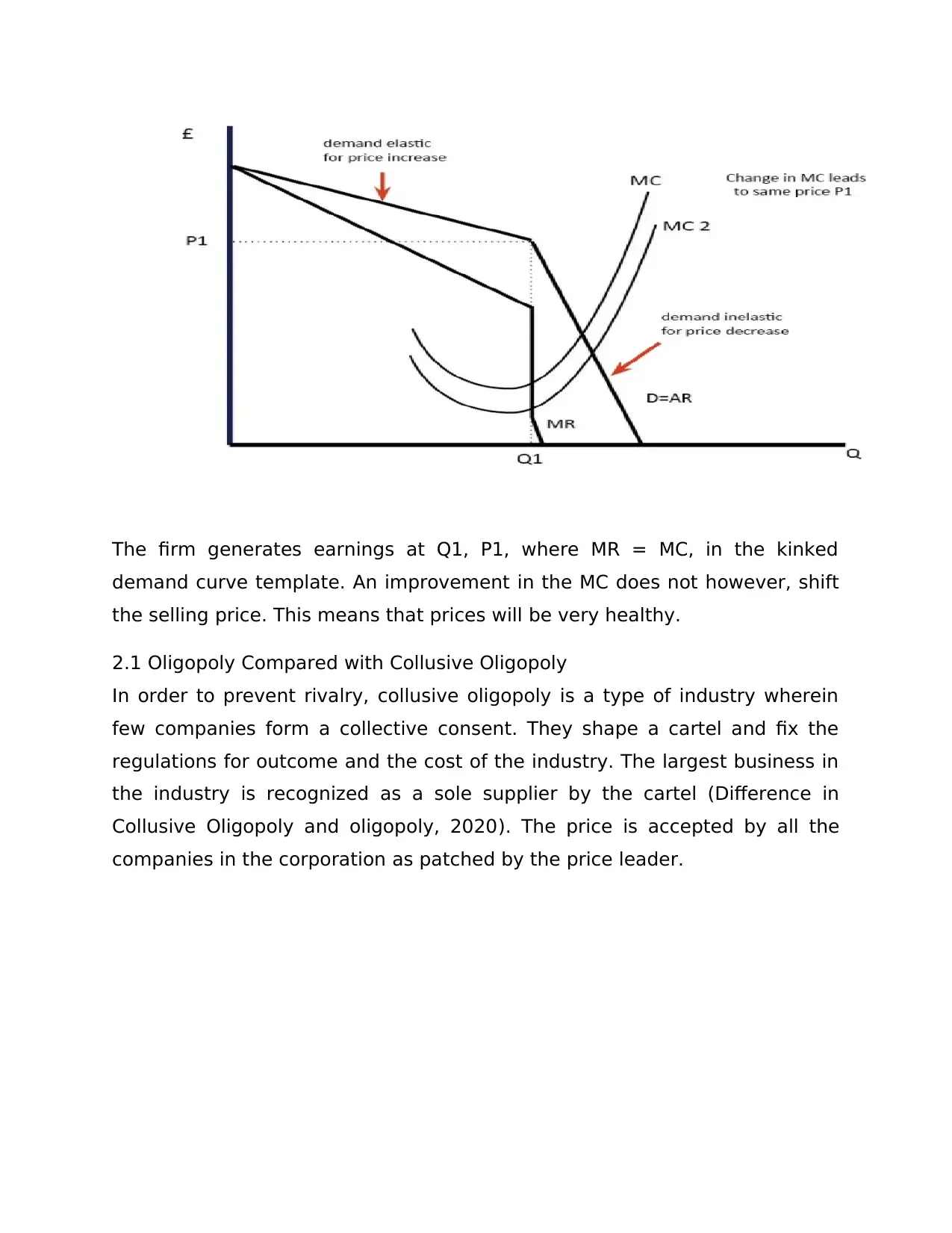
The firm generates earnings at Q1, P1, where MR = MC, in the kinked
demand curve template. An improvement in the MC does not however, shift
the selling price. This means that prices will be very healthy.
2.1 Oligopoly Compared with Collusive Oligopoly
In order to prevent rivalry, collusive oligopoly is a type of industry wherein
few companies form a collective consent. They shape a cartel and fix the
regulations for outcome and the cost of the industry. The largest business in
the industry is recognized as a sole supplier by the cartel (Difference in
Collusive Oligopoly and oligopoly, 2020). The price is accepted by all the
companies in the corporation as patched by the price leader.
demand curve template. An improvement in the MC does not however, shift
the selling price. This means that prices will be very healthy.
2.1 Oligopoly Compared with Collusive Oligopoly
In order to prevent rivalry, collusive oligopoly is a type of industry wherein
few companies form a collective consent. They shape a cartel and fix the
regulations for outcome and the cost of the industry. The largest business in
the industry is recognized as a sole supplier by the cartel (Difference in
Collusive Oligopoly and oligopoly, 2020). The price is accepted by all the
companies in the corporation as patched by the price leader.
Paraphrase This Document
Need a fresh take? Get an instant paraphrase of this document with our AI Paraphraser
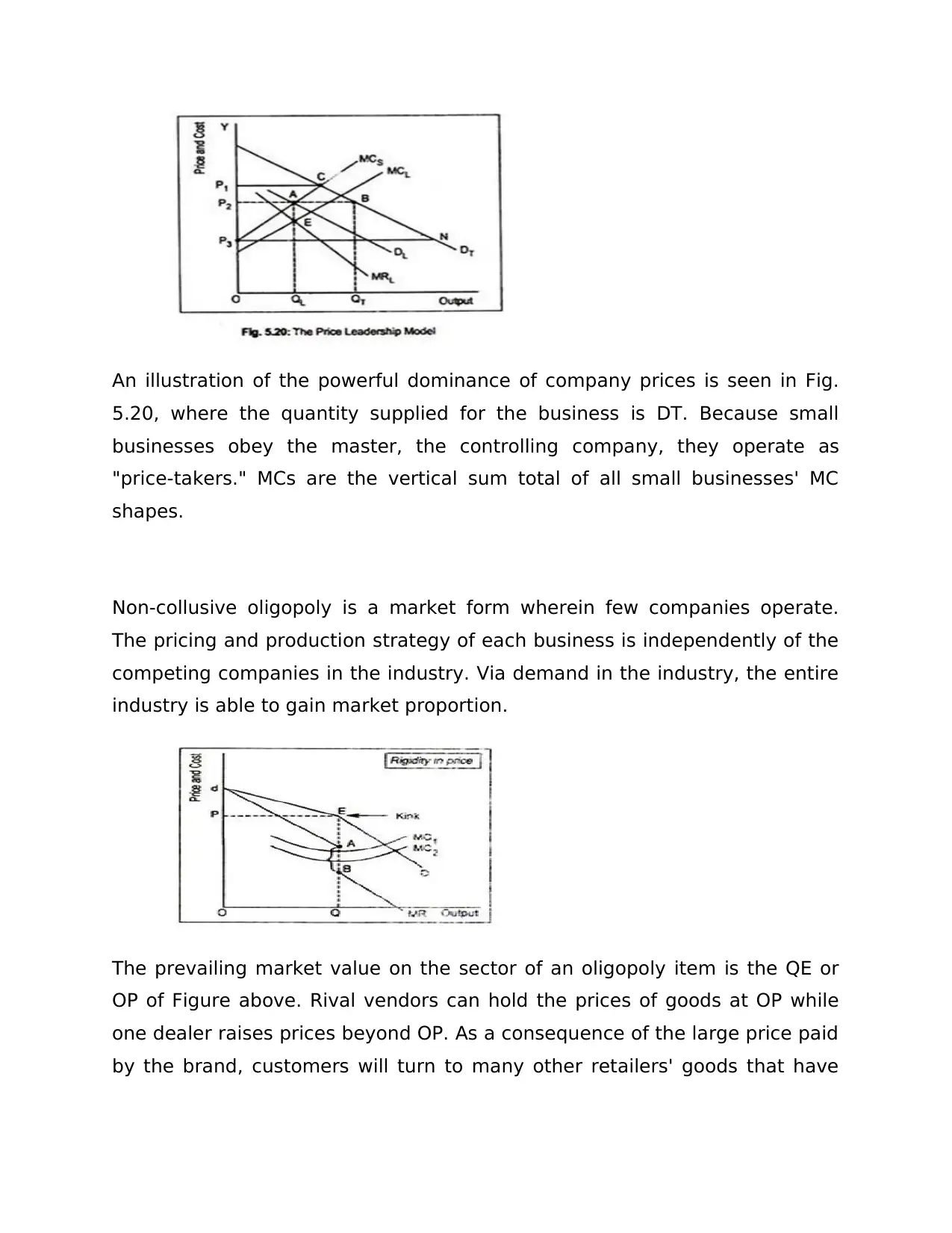
An illustration of the powerful dominance of company prices is seen in Fig.
5.20, where the quantity supplied for the business is DT. Because small
businesses obey the master, the controlling company, they operate as
"price-takers." MCs are the vertical sum total of all small businesses' MC
shapes.
Non-collusive oligopoly is a market form wherein few companies operate.
The pricing and production strategy of each business is independently of the
competing companies in the industry. Via demand in the industry, the entire
industry is able to gain market proportion.
The prevailing market value on the sector of an oligopoly item is the QE or
OP of Figure above. Rival vendors can hold the prices of goods at OP while
one dealer raises prices beyond OP. As a consequence of the large price paid
by the brand, customers will turn to many other retailers' goods that have
5.20, where the quantity supplied for the business is DT. Because small
businesses obey the master, the controlling company, they operate as
"price-takers." MCs are the vertical sum total of all small businesses' MC
shapes.
Non-collusive oligopoly is a market form wherein few companies operate.
The pricing and production strategy of each business is independently of the
competing companies in the industry. Via demand in the industry, the entire
industry is able to gain market proportion.
The prevailing market value on the sector of an oligopoly item is the QE or
OP of Figure above. Rival vendors can hold the prices of goods at OP while
one dealer raises prices beyond OP. As a consequence of the large price paid
by the brand, customers will turn to many other retailers' goods that have
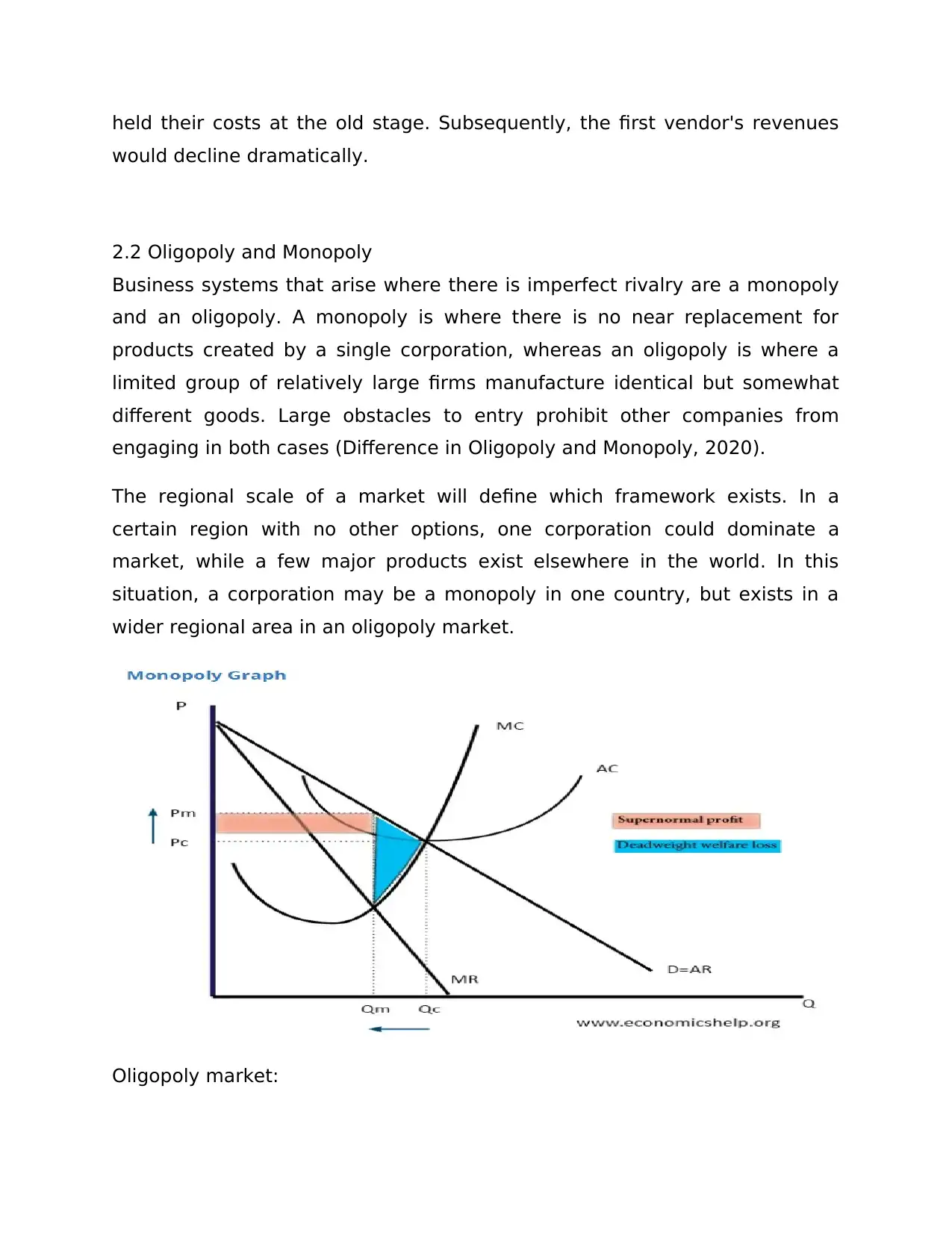
held their costs at the old stage. Subsequently, the first vendor's revenues
would decline dramatically.
2.2 Oligopoly and Monopoly
Business systems that arise where there is imperfect rivalry are a monopoly
and an oligopoly. A monopoly is where there is no near replacement for
products created by a single corporation, whereas an oligopoly is where a
limited group of relatively large firms manufacture identical but somewhat
different goods. Large obstacles to entry prohibit other companies from
engaging in both cases (Difference in Oligopoly and Monopoly, 2020).
The regional scale of a market will define which framework exists. In a
certain region with no other options, one corporation could dominate a
market, while a few major products exist elsewhere in the world. In this
situation, a corporation may be a monopoly in one country, but exists in a
wider regional area in an oligopoly market.
Oligopoly market:
would decline dramatically.
2.2 Oligopoly and Monopoly
Business systems that arise where there is imperfect rivalry are a monopoly
and an oligopoly. A monopoly is where there is no near replacement for
products created by a single corporation, whereas an oligopoly is where a
limited group of relatively large firms manufacture identical but somewhat
different goods. Large obstacles to entry prohibit other companies from
engaging in both cases (Difference in Oligopoly and Monopoly, 2020).
The regional scale of a market will define which framework exists. In a
certain region with no other options, one corporation could dominate a
market, while a few major products exist elsewhere in the world. In this
situation, a corporation may be a monopoly in one country, but exists in a
wider regional area in an oligopoly market.
Oligopoly market:
⊘ This is a preview!⊘
Do you want full access?
Subscribe today to unlock all pages.

Trusted by 1+ million students worldwide
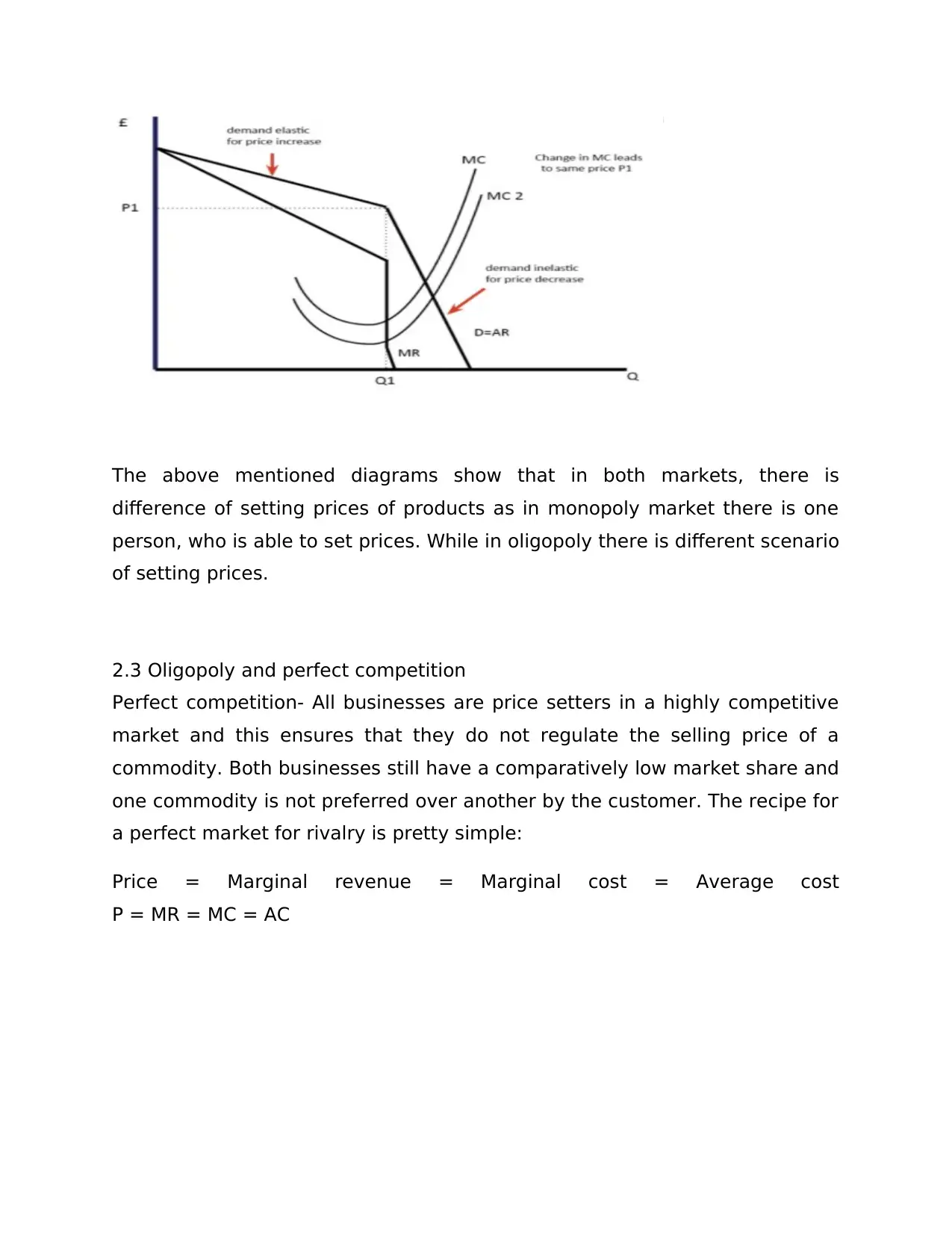
The above mentioned diagrams show that in both markets, there is
difference of setting prices of products as in monopoly market there is one
person, who is able to set prices. While in oligopoly there is different scenario
of setting prices.
2.3 Oligopoly and perfect competition
Perfect competition- All businesses are price setters in a highly competitive
market and this ensures that they do not regulate the selling price of a
commodity. Both businesses still have a comparatively low market share and
one commodity is not preferred over another by the customer. The recipe for
a perfect market for rivalry is pretty simple:
Price = Marginal revenue = Marginal cost = Average cost
P = MR = MC = AC
difference of setting prices of products as in monopoly market there is one
person, who is able to set prices. While in oligopoly there is different scenario
of setting prices.
2.3 Oligopoly and perfect competition
Perfect competition- All businesses are price setters in a highly competitive
market and this ensures that they do not regulate the selling price of a
commodity. Both businesses still have a comparatively low market share and
one commodity is not preferred over another by the customer. The recipe for
a perfect market for rivalry is pretty simple:
Price = Marginal revenue = Marginal cost = Average cost
P = MR = MC = AC
Paraphrase This Document
Need a fresh take? Get an instant paraphrase of this document with our AI Paraphraser
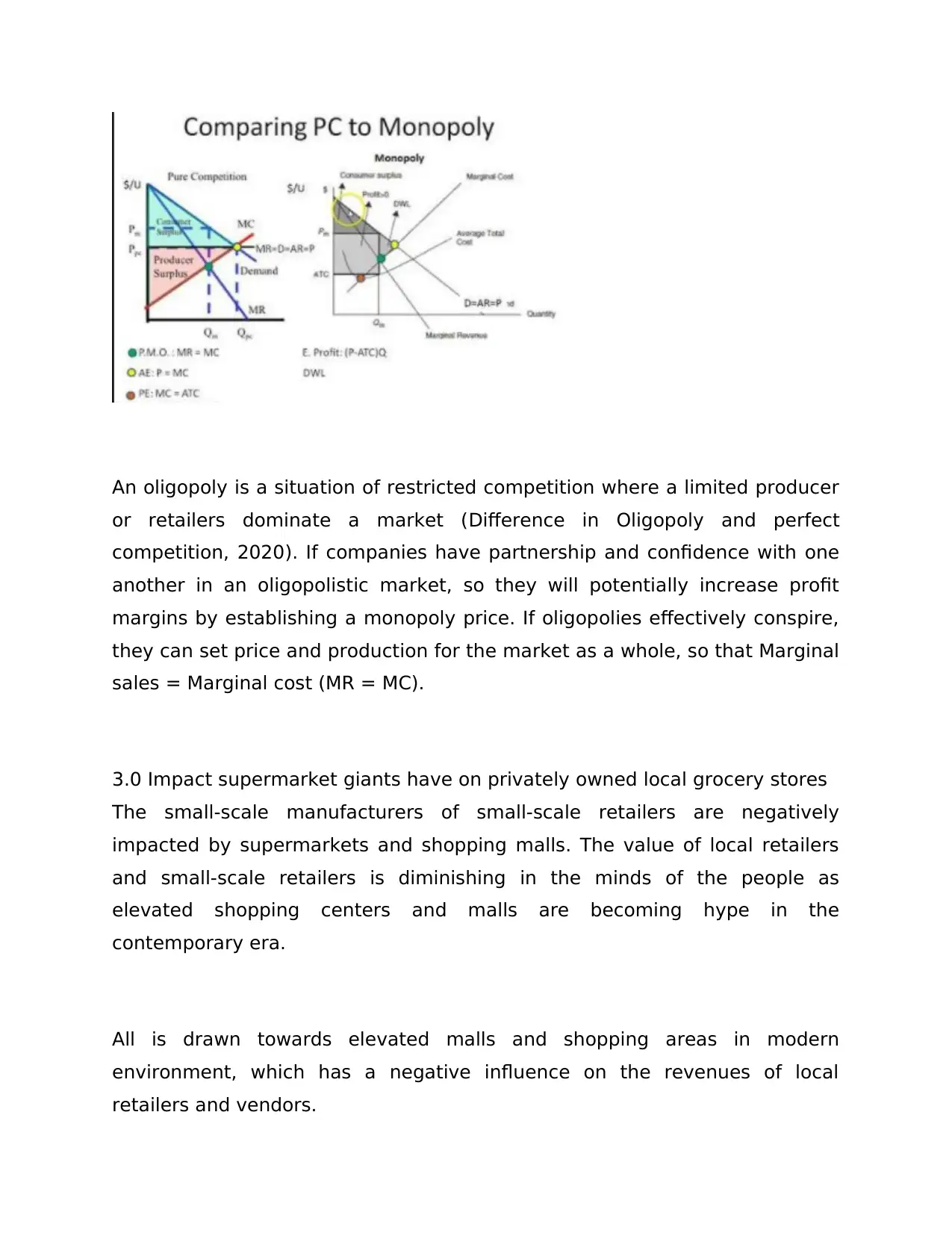
An oligopoly is a situation of restricted competition where a limited producer
or retailers dominate a market (Difference in Oligopoly and perfect
competition, 2020). If companies have partnership and confidence with one
another in an oligopolistic market, so they will potentially increase profit
margins by establishing a monopoly price. If oligopolies effectively conspire,
they can set price and production for the market as a whole, so that Marginal
sales = Marginal cost (MR = MC).
3.0 Impact supermarket giants have on privately owned local grocery stores
The small-scale manufacturers of small-scale retailers are negatively
impacted by supermarkets and shopping malls. The value of local retailers
and small-scale retailers is diminishing in the minds of the people as
elevated shopping centers and malls are becoming hype in the
contemporary era.
All is drawn towards elevated malls and shopping areas in modern
environment, which has a negative influence on the revenues of local
retailers and vendors.
or retailers dominate a market (Difference in Oligopoly and perfect
competition, 2020). If companies have partnership and confidence with one
another in an oligopolistic market, so they will potentially increase profit
margins by establishing a monopoly price. If oligopolies effectively conspire,
they can set price and production for the market as a whole, so that Marginal
sales = Marginal cost (MR = MC).
3.0 Impact supermarket giants have on privately owned local grocery stores
The small-scale manufacturers of small-scale retailers are negatively
impacted by supermarkets and shopping malls. The value of local retailers
and small-scale retailers is diminishing in the minds of the people as
elevated shopping centers and malls are becoming hype in the
contemporary era.
All is drawn towards elevated malls and shopping areas in modern
environment, which has a negative influence on the revenues of local
retailers and vendors.
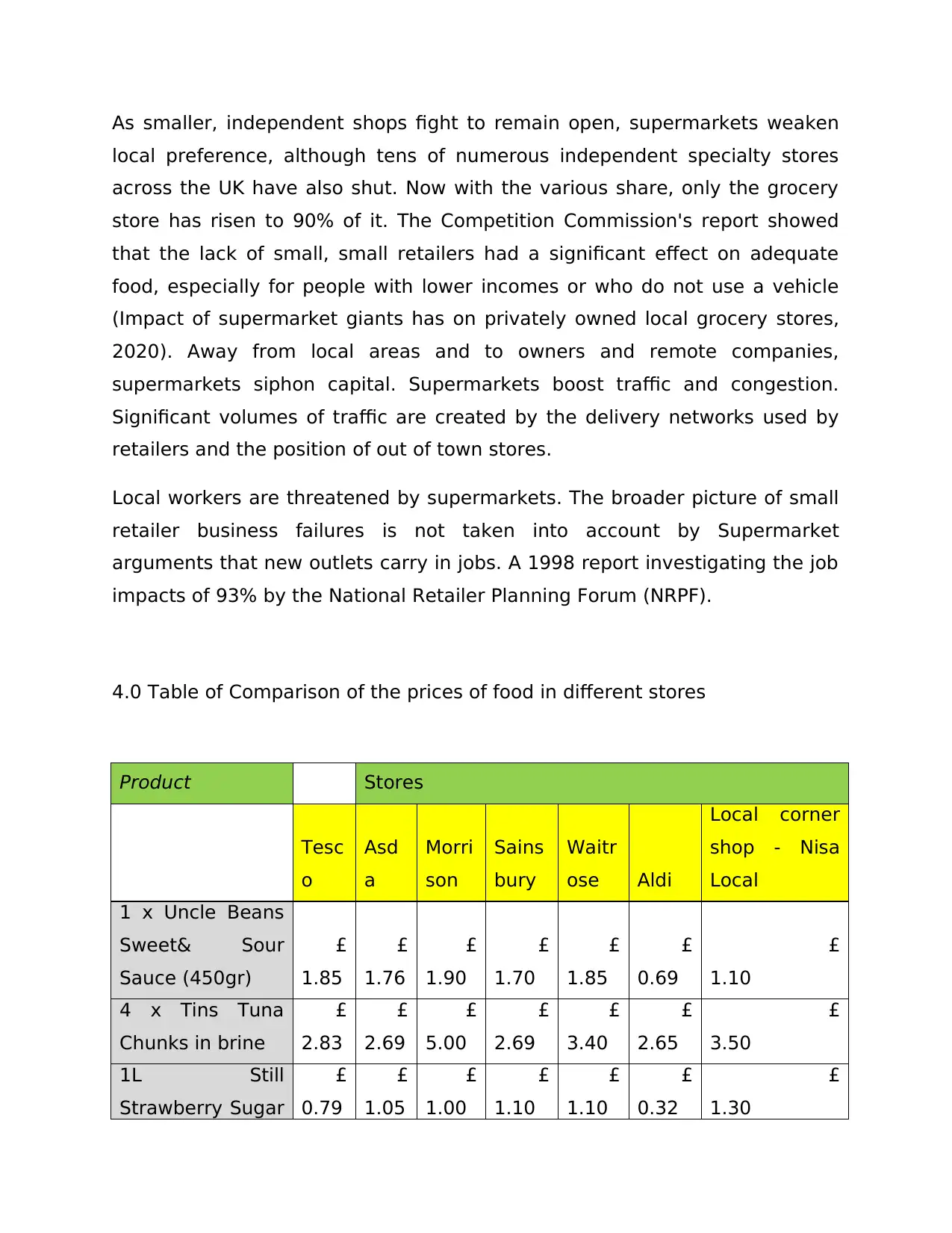
As smaller, independent shops fight to remain open, supermarkets weaken
local preference, although tens of numerous independent specialty stores
across the UK have also shut. Now with the various share, only the grocery
store has risen to 90% of it. The Competition Commission's report showed
that the lack of small, small retailers had a significant effect on adequate
food, especially for people with lower incomes or who do not use a vehicle
(Impact of supermarket giants has on privately owned local grocery stores,
2020). Away from local areas and to owners and remote companies,
supermarkets siphon capital. Supermarkets boost traffic and congestion.
Significant volumes of traffic are created by the delivery networks used by
retailers and the position of out of town stores.
Local workers are threatened by supermarkets. The broader picture of small
retailer business failures is not taken into account by Supermarket
arguments that new outlets carry in jobs. A 1998 report investigating the job
impacts of 93% by the National Retailer Planning Forum (NRPF).
4.0 Table of Comparison of the prices of food in different stores
Product Stores
Tesc
o
Asd
a
Morri
son
Sains
bury
Waitr
ose Aldi
Local corner
shop - Nisa
Local
1 x Uncle Beans
Sweet& Sour
Sauce (450gr)
£
1.85
£
1.76
£
1.90
£
1.70
£
1.85
£
0.69
£
1.10
4 x Tins Tuna
Chunks in brine
£
2.83
£
2.69
£
5.00
£
2.69
£
3.40
£
2.65
£
3.50
1L Still
Strawberry Sugar
£
0.79
£
1.05
£
1.00
£
1.10
£
1.10
£
0.32
£
1.30
local preference, although tens of numerous independent specialty stores
across the UK have also shut. Now with the various share, only the grocery
store has risen to 90% of it. The Competition Commission's report showed
that the lack of small, small retailers had a significant effect on adequate
food, especially for people with lower incomes or who do not use a vehicle
(Impact of supermarket giants has on privately owned local grocery stores,
2020). Away from local areas and to owners and remote companies,
supermarkets siphon capital. Supermarkets boost traffic and congestion.
Significant volumes of traffic are created by the delivery networks used by
retailers and the position of out of town stores.
Local workers are threatened by supermarkets. The broader picture of small
retailer business failures is not taken into account by Supermarket
arguments that new outlets carry in jobs. A 1998 report investigating the job
impacts of 93% by the National Retailer Planning Forum (NRPF).
4.0 Table of Comparison of the prices of food in different stores
Product Stores
Tesc
o
Asd
a
Morri
son
Sains
bury
Waitr
ose Aldi
Local corner
shop - Nisa
Local
1 x Uncle Beans
Sweet& Sour
Sauce (450gr)
£
1.85
£
1.76
£
1.90
£
1.70
£
1.85
£
0.69
£
1.10
4 x Tins Tuna
Chunks in brine
£
2.83
£
2.69
£
5.00
£
2.69
£
3.40
£
2.65
£
3.50
1L Still
Strawberry Sugar
£
0.79
£
1.05
£
1.00
£
1.10
£
1.10
£
0.32
£
1.30
⊘ This is a preview!⊘
Do you want full access?
Subscribe today to unlock all pages.

Trusted by 1+ million students worldwide
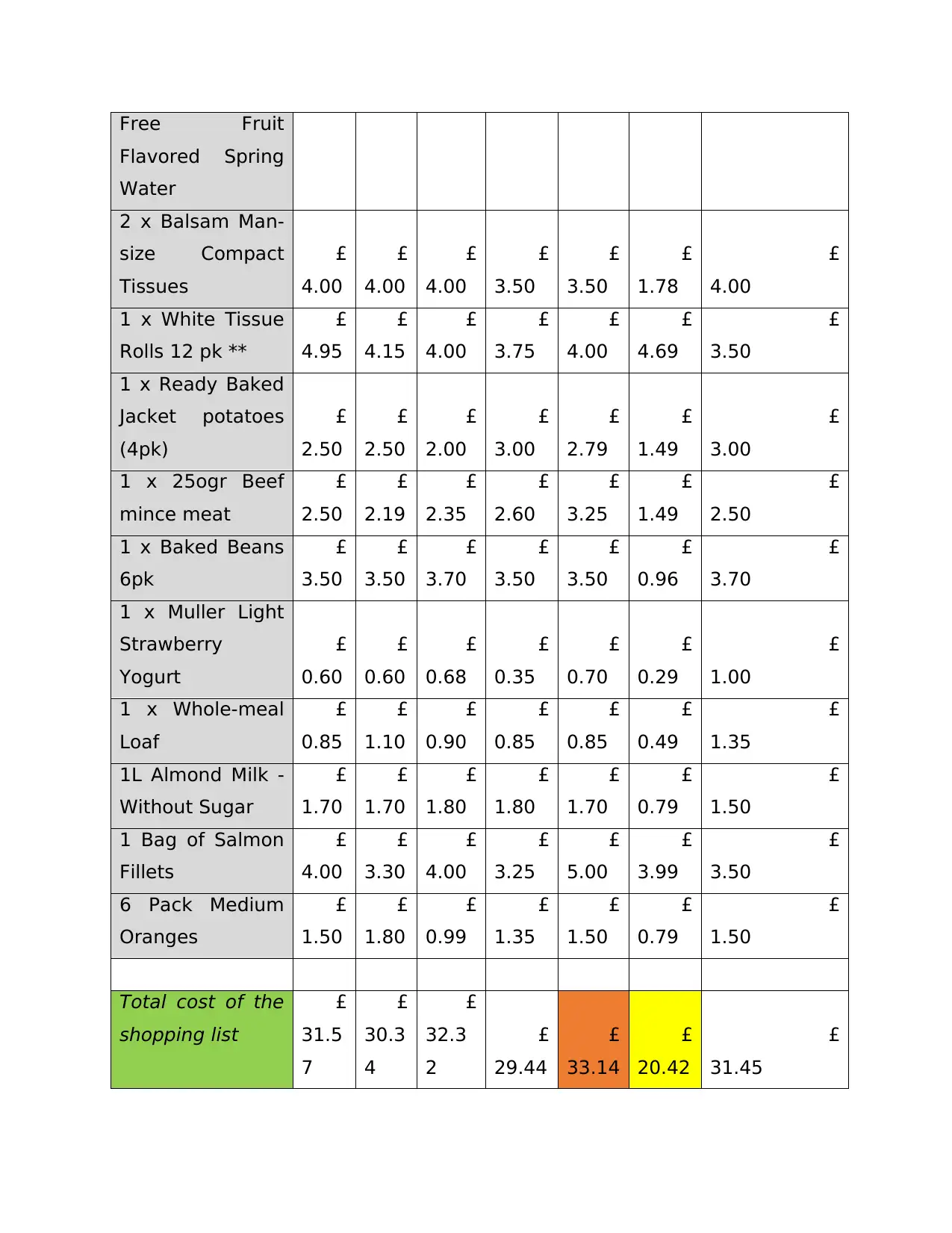
Free Fruit
Flavored Spring
Water
2 x Balsam Man-
size Compact
Tissues
£
4.00
£
4.00
£
4.00
£
3.50
£
3.50
£
1.78
£
4.00
1 x White Tissue
Rolls 12 pk **
£
4.95
£
4.15
£
4.00
£
3.75
£
4.00
£
4.69
£
3.50
1 x Ready Baked
Jacket potatoes
(4pk)
£
2.50
£
2.50
£
2.00
£
3.00
£
2.79
£
1.49
£
3.00
1 x 25ogr Beef
mince meat
£
2.50
£
2.19
£
2.35
£
2.60
£
3.25
£
1.49
£
2.50
1 x Baked Beans
6pk
£
3.50
£
3.50
£
3.70
£
3.50
£
3.50
£
0.96
£
3.70
1 x Muller Light
Strawberry
Yogurt
£
0.60
£
0.60
£
0.68
£
0.35
£
0.70
£
0.29
£
1.00
1 x Whole-meal
Loaf
£
0.85
£
1.10
£
0.90
£
0.85
£
0.85
£
0.49
£
1.35
1L Almond Milk -
Without Sugar
£
1.70
£
1.70
£
1.80
£
1.80
£
1.70
£
0.79
£
1.50
1 Bag of Salmon
Fillets
£
4.00
£
3.30
£
4.00
£
3.25
£
5.00
£
3.99
£
3.50
6 Pack Medium
Oranges
£
1.50
£
1.80
£
0.99
£
1.35
£
1.50
£
0.79
£
1.50
Total cost of the
shopping list
£
31.5
7
£
30.3
4
£
32.3
2
£
29.44
£
33.14
£
20.42
£
31.45
Flavored Spring
Water
2 x Balsam Man-
size Compact
Tissues
£
4.00
£
4.00
£
4.00
£
3.50
£
3.50
£
1.78
£
4.00
1 x White Tissue
Rolls 12 pk **
£
4.95
£
4.15
£
4.00
£
3.75
£
4.00
£
4.69
£
3.50
1 x Ready Baked
Jacket potatoes
(4pk)
£
2.50
£
2.50
£
2.00
£
3.00
£
2.79
£
1.49
£
3.00
1 x 25ogr Beef
mince meat
£
2.50
£
2.19
£
2.35
£
2.60
£
3.25
£
1.49
£
2.50
1 x Baked Beans
6pk
£
3.50
£
3.50
£
3.70
£
3.50
£
3.50
£
0.96
£
3.70
1 x Muller Light
Strawberry
Yogurt
£
0.60
£
0.60
£
0.68
£
0.35
£
0.70
£
0.29
£
1.00
1 x Whole-meal
Loaf
£
0.85
£
1.10
£
0.90
£
0.85
£
0.85
£
0.49
£
1.35
1L Almond Milk -
Without Sugar
£
1.70
£
1.70
£
1.80
£
1.80
£
1.70
£
0.79
£
1.50
1 Bag of Salmon
Fillets
£
4.00
£
3.30
£
4.00
£
3.25
£
5.00
£
3.99
£
3.50
6 Pack Medium
Oranges
£
1.50
£
1.80
£
0.99
£
1.35
£
1.50
£
0.79
£
1.50
Total cost of the
shopping list
£
31.5
7
£
30.3
4
£
32.3
2
£
29.44
£
33.14
£
20.42
£
31.45
Paraphrase This Document
Need a fresh take? Get an instant paraphrase of this document with our AI Paraphraser
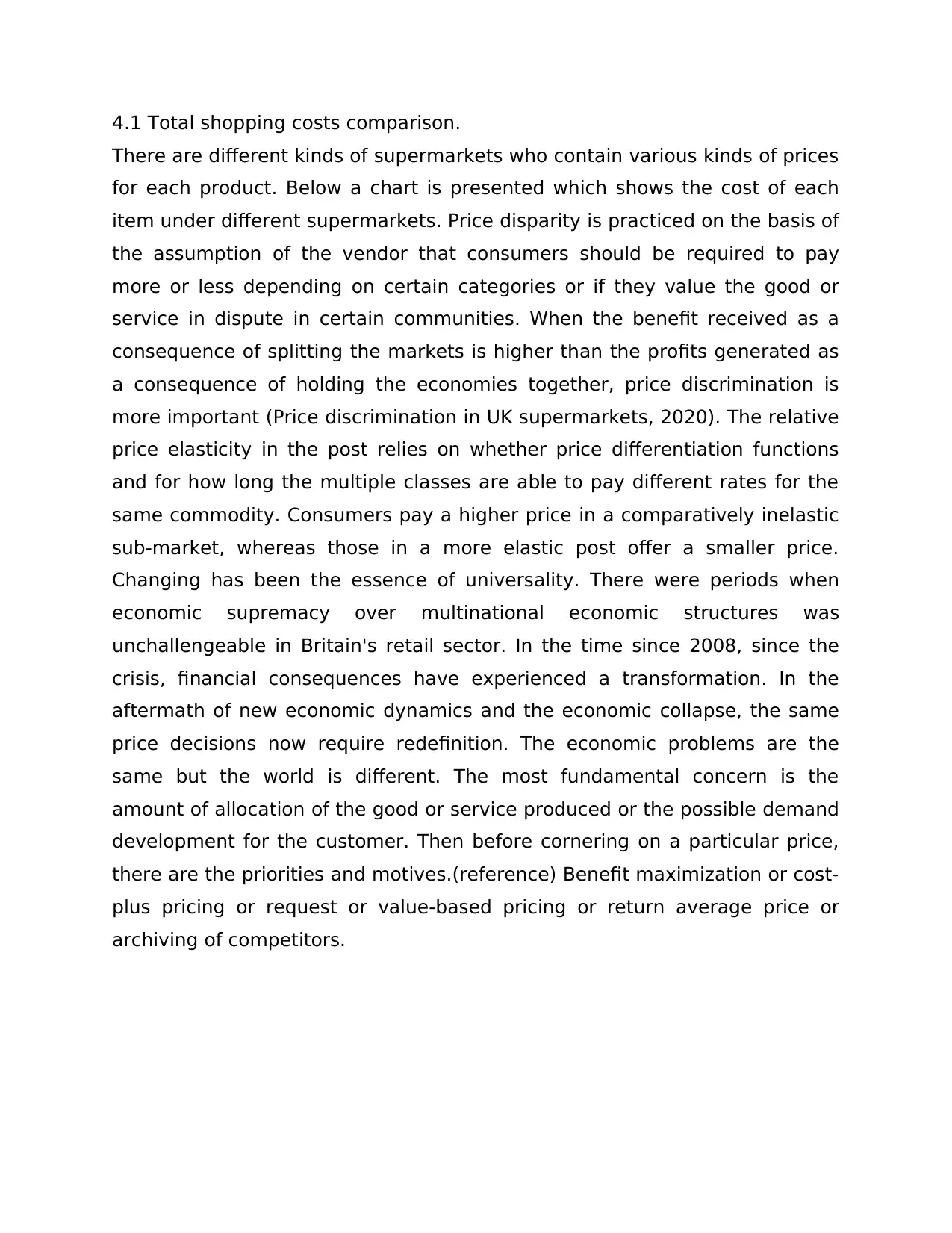
4.1 Total shopping costs comparison.
There are different kinds of supermarkets who contain various kinds of prices
for each product. Below a chart is presented which shows the cost of each
item under different supermarkets. Price disparity is practiced on the basis of
the assumption of the vendor that consumers should be required to pay
more or less depending on certain categories or if they value the good or
service in dispute in certain communities. When the benefit received as a
consequence of splitting the markets is higher than the profits generated as
a consequence of holding the economies together, price discrimination is
more important (Price discrimination in UK supermarkets, 2020). The relative
price elasticity in the post relies on whether price differentiation functions
and for how long the multiple classes are able to pay different rates for the
same commodity. Consumers pay a higher price in a comparatively inelastic
sub-market, whereas those in a more elastic post offer a smaller price.
Changing has been the essence of universality. There were periods when
economic supremacy over multinational economic structures was
unchallengeable in Britain's retail sector. In the time since 2008, since the
crisis, financial consequences have experienced a transformation. In the
aftermath of new economic dynamics and the economic collapse, the same
price decisions now require redefinition. The economic problems are the
same but the world is different. The most fundamental concern is the
amount of allocation of the good or service produced or the possible demand
development for the customer. Then before cornering on a particular price,
there are the priorities and motives.(reference) Benefit maximization or cost-
plus pricing or request or value-based pricing or return average price or
archiving of competitors.
There are different kinds of supermarkets who contain various kinds of prices
for each product. Below a chart is presented which shows the cost of each
item under different supermarkets. Price disparity is practiced on the basis of
the assumption of the vendor that consumers should be required to pay
more or less depending on certain categories or if they value the good or
service in dispute in certain communities. When the benefit received as a
consequence of splitting the markets is higher than the profits generated as
a consequence of holding the economies together, price discrimination is
more important (Price discrimination in UK supermarkets, 2020). The relative
price elasticity in the post relies on whether price differentiation functions
and for how long the multiple classes are able to pay different rates for the
same commodity. Consumers pay a higher price in a comparatively inelastic
sub-market, whereas those in a more elastic post offer a smaller price.
Changing has been the essence of universality. There were periods when
economic supremacy over multinational economic structures was
unchallengeable in Britain's retail sector. In the time since 2008, since the
crisis, financial consequences have experienced a transformation. In the
aftermath of new economic dynamics and the economic collapse, the same
price decisions now require redefinition. The economic problems are the
same but the world is different. The most fundamental concern is the
amount of allocation of the good or service produced or the possible demand
development for the customer. Then before cornering on a particular price,
there are the priorities and motives.(reference) Benefit maximization or cost-
plus pricing or request or value-based pricing or return average price or
archiving of competitors.
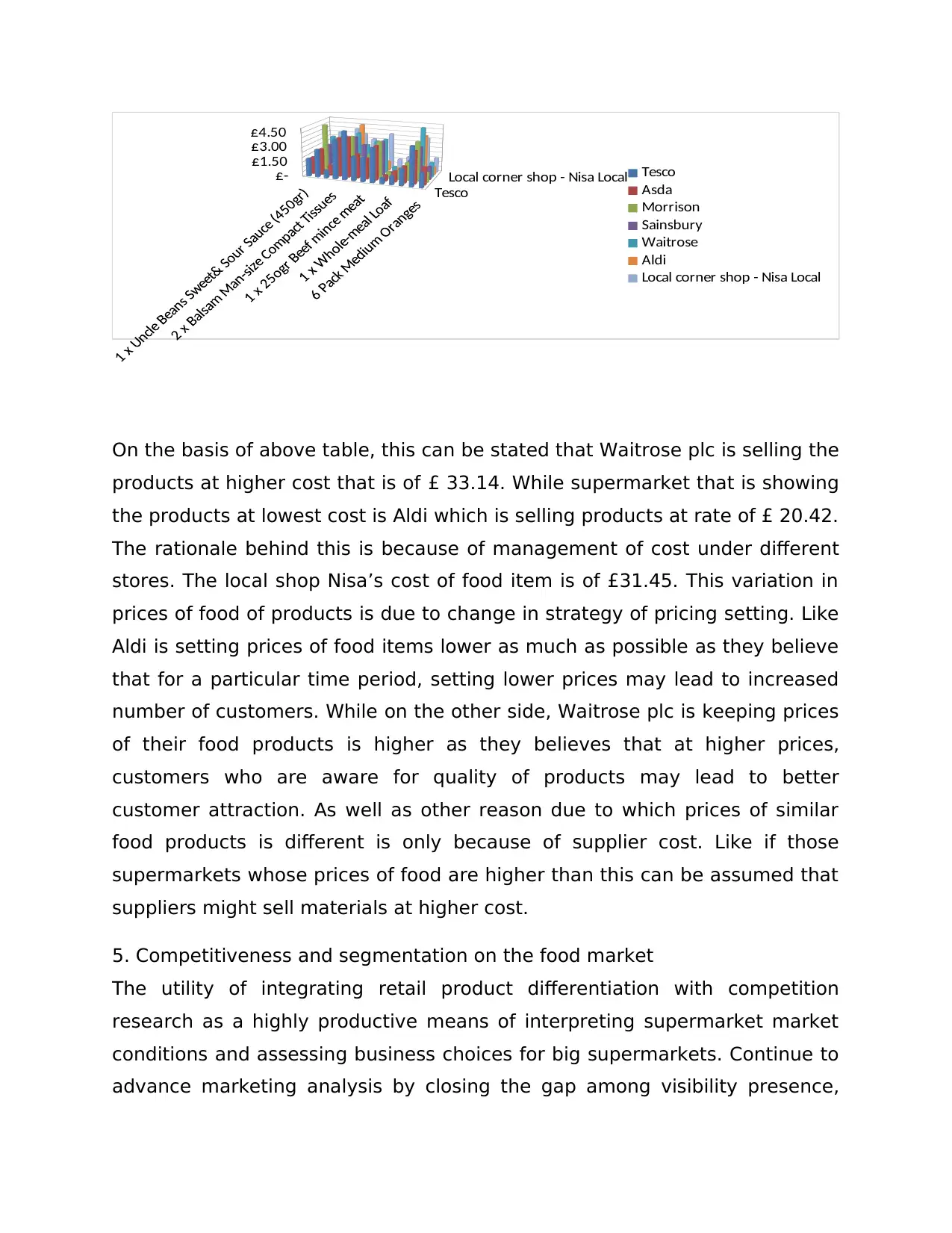
£-
£1.50
£3.00
£4.50
Tesco
Local corner shop - Nisa Local Tesco
Asda
Morrison
Sainsbury
Waitrose
Aldi
Local corner shop - Nisa Local
On the basis of above table, this can be stated that Waitrose plc is selling the
products at higher cost that is of £ 33.14. While supermarket that is showing
the products at lowest cost is Aldi which is selling products at rate of £ 20.42.
The rationale behind this is because of management of cost under different
stores. The local shop Nisa’s cost of food item is of £31.45. This variation in
prices of food of products is due to change in strategy of pricing setting. Like
Aldi is setting prices of food items lower as much as possible as they believe
that for a particular time period, setting lower prices may lead to increased
number of customers. While on the other side, Waitrose plc is keeping prices
of their food products is higher as they believes that at higher prices,
customers who are aware for quality of products may lead to better
customer attraction. As well as other reason due to which prices of similar
food products is different is only because of supplier cost. Like if those
supermarkets whose prices of food are higher than this can be assumed that
suppliers might sell materials at higher cost.
5. Competitiveness and segmentation on the food market
The utility of integrating retail product differentiation with competition
research as a highly productive means of interpreting supermarket market
conditions and assessing business choices for big supermarkets. Continue to
advance marketing analysis by closing the gap among visibility presence,
£1.50
£3.00
£4.50
Tesco
Local corner shop - Nisa Local Tesco
Asda
Morrison
Sainsbury
Waitrose
Aldi
Local corner shop - Nisa Local
On the basis of above table, this can be stated that Waitrose plc is selling the
products at higher cost that is of £ 33.14. While supermarket that is showing
the products at lowest cost is Aldi which is selling products at rate of £ 20.42.
The rationale behind this is because of management of cost under different
stores. The local shop Nisa’s cost of food item is of £31.45. This variation in
prices of food of products is due to change in strategy of pricing setting. Like
Aldi is setting prices of food items lower as much as possible as they believe
that for a particular time period, setting lower prices may lead to increased
number of customers. While on the other side, Waitrose plc is keeping prices
of their food products is higher as they believes that at higher prices,
customers who are aware for quality of products may lead to better
customer attraction. As well as other reason due to which prices of similar
food products is different is only because of supplier cost. Like if those
supermarkets whose prices of food are higher than this can be assumed that
suppliers might sell materials at higher cost.
5. Competitiveness and segmentation on the food market
The utility of integrating retail product differentiation with competition
research as a highly productive means of interpreting supermarket market
conditions and assessing business choices for big supermarkets. Continue to
advance marketing analysis by closing the gap among visibility presence,
⊘ This is a preview!⊘
Do you want full access?
Subscribe today to unlock all pages.

Trusted by 1+ million students worldwide
1 out of 17
Related Documents
Your All-in-One AI-Powered Toolkit for Academic Success.
+13062052269
info@desklib.com
Available 24*7 on WhatsApp / Email
![[object Object]](/_next/static/media/star-bottom.7253800d.svg)
Unlock your academic potential
Copyright © 2020–2025 A2Z Services. All Rights Reserved. Developed and managed by ZUCOL.





